Table of contents
Understanding lifecycle marketing: A strategic approach to customer engagement
Aug 15, 2025
10 mins read
Written by Esha Shabbir

Imagine this: you’ve just launched your latest product and the first sales come through. Everything seems to be on track until, out of nowhere, the momentum slows down. The excitement fades, and you’re left wondering what went wrong.
Your analytics tell part of the story: where customers showed interest, where they drifted away, and which moments kept them engaged. The real magic comes when you use those insights to guide what happens next.
This is where lifecycle marketing comes in. It’s not about bombarding your audience with the same old pitch over and over again; it’s about crafting a tailored experience that evolves with your customers. Done right, it can transform a one-time shopper into a loyal advocate.
Let’s dive into how it works.
What is lifecycle marketing?
Think of lifecycle marketing as a thoughtful conversation with your customers; one that evolves as they do.
It’s a strategy that nurtures customer relationships at every stage, from initial awareness to becoming loyal advocates. This approach shifts the focus from short-term gains to long-term loyalty, emphasizing the importance of nurturing customer relationships throughout their entire lifecycle.
In today’s competitive market, a single sale doesn’t define success. Nurturing customer relationships has become essential. And with the help of analytics, you can make data-driven decisions to ensure your efforts are hitting the mark.
By leveraging insights to gain a deeper understanding of your customers, you can create more relevant and tailored experiences that keep them coming back.
Benefits of implementing lifecycle marketing
So, why should you invest time and effort into lifecycle marketing?
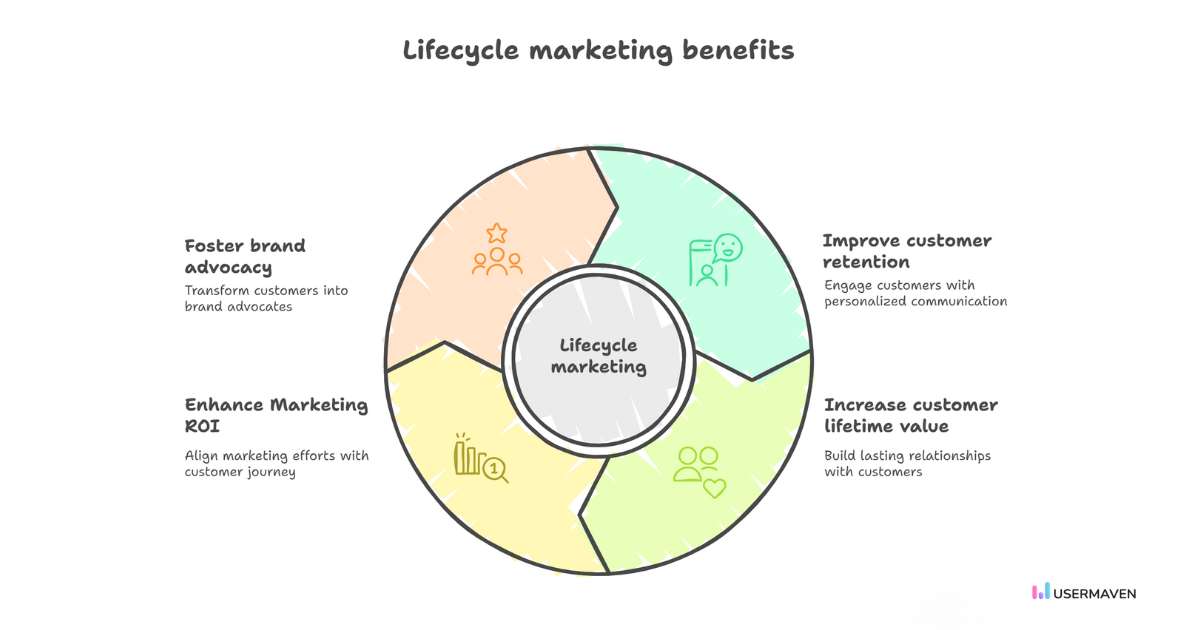
The answer is pretty simple: it pays off in big ways. By nurturing customer relationships throughout their journey, you unlock a range of benefits that can transform your business. Let’s dive into how lifecycle marketing can help you achieve long-term success.
Improved customer retention
You’ve probably heard it before: it costs more to acquire a new customer than to retain an existing one. That’s because once you’ve made a sale, the real work begins, keeping them engaged and satisfied.
And lifecycle marketing helps you do just that. By understanding your customers’ journey from start to finish, you can craft messages that speak directly to their needs, whether they’re just getting started or are loyal, repeat buyers.
Personalized communication is key to keeping customers engaged throughout their journey. Whether it’s through timely emails, product updates, or exclusive offers, you ensure they feel valued at every touchpoint. In fact, many brands are already tapping into the power of real-time data to enhance these interactions. Over half of brands (51%) now tailor their messaging based on real-time customer behavior and preferences, ensuring that their communication resonates with each individual when it matters most.
Loyalty programs also play a significant role in retention. By rewarding repeat purchases and offering exclusive deals, you create strong incentives for customers to stay. When they feel appreciated, they’re much more likely to remain loyal, reducing churn and boosting long-term satisfaction.
Increased customer lifetime value
Lifecycle marketing isn’t just about making a sale; it’s about building lasting relationships. By staying engaged and delivering consistent value, you set the stage for repeat purchases and even greater opportunities down the line.
Tracking customer lifetime value (LTV) provides a clear picture of each customer’s worth over time. This insight allows you to refine your strategies, ensuring that every interaction adds value.
Whether it’s through personalized recommendations, tailored rewards, or understanding their evolving needs, lifecycle marketing helps you focus on what truly matters: building relationships that last.
Enhancing marketing ROI
Lifecycle marketing is about working smarter, not harder. Instead of casting a wide net with broad campaigns, you’re strategically aligning your efforts with where each customer stands in their journey. This means leveraging data to understand their behaviors and needs, ensuring your marketing resonates at the right moment.
By tracking ROI and harnessing data-driven insights, you ensure that every marketing dollar is well spent. Whether through segmentation, personalized messaging, or analyzing campaign outcomes, you can continuously refine your approach for better returns.
Lifecycle marketing empowers you to focus on what truly works, maximizing value at every step.
Stronger brand advocacy
One of the most rewarding benefits of lifecycle marketing is its ability to transform satisfied customers into passionate brand advocates. When customers feel valued and engaged throughout their journey, they’re more inclined to share their positive experiences with others. Whether through referrals, reviews, or word-of-mouth recommendations, these advocates help expand your reach and grow your audience.
By keeping customers engaged and delivering consistent value, you cultivate loyal fans who are eager to spread the word. Customer loyalty analytics play a pivotal role in this process, providing valuable insights into behaviors and preferences that help you identify and nurture these advocates. These advocates are invaluable, driving not only direct sales but also enhancing your brand’s credibility and reputation.
Stages of lifecycle marketing
Think of your customer journey as a well-planned road trip. You wouldn’t just jump in and drive aimlessly, right? You’d map out your route, plan your stops, and ensure you’re heading toward a meaningful destination.
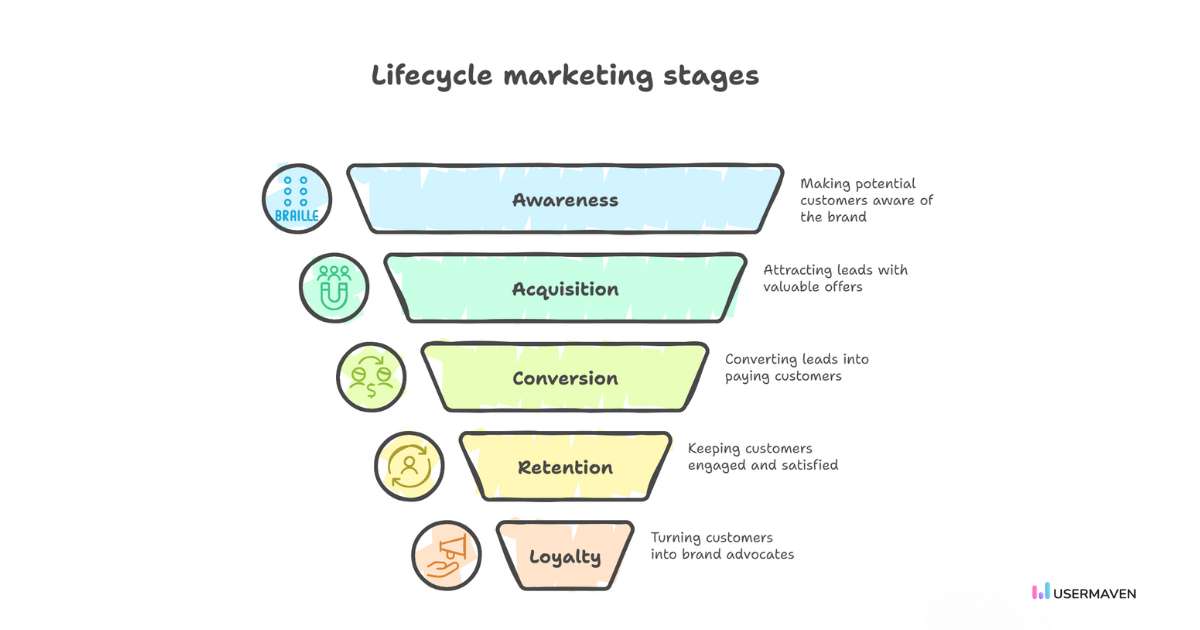
Similarly, lifecycle marketing is about guiding your customers through a thoughtfully designed path, from discovering your brand to becoming loyal advocates. Let’s walk through each stage and see how you can make the most of every step.
Awareness
Your customer’s journey begins with awareness. At this stage, potential customers are just discovering your brand. They may not be aware of the need for your product yet, but your goal is to make them aware of your solution.
For instance, a sustainable fashion brand may post eco-friendly fashion tips and guides on Instagram to attract environmentally-conscious users. This is when you make that first impression: getting people to think, “Hmm, I could use this.”
Tracking engagement through analytics tools can help you understand which content is performing best in reaching your audience. Dashboards can help you visualize this, showing how visitors are finding you and where they’re spending the most time. This insight is crucial for refining your strategies and targeting the right audience.
Acquisition
Once you’ve made it onto their radar, it’s time to turn that awareness into actual leads. The focus here is on offering something of value that grabs their attention, whether that’s a discount, a free trial, or even a helpful e-book. For example, a software company might offer a free month of service in exchange for a user’s email. The goal is to move the conversation from “Take a look at this” to “I want to know more.”
To do this effectively, you need to track how visitors are moving through your acquisition funnel. By using funnel analysis, you can pinpoint where prospects drop off and adjust your marketing tactics accordingly. Whether it’s refining your messaging, simplifying your form, or offering a more compelling incentive, this helps keep them engaged and moving toward conversion.
And this is where customer journey mapping comes into play. By understanding how users interact with your website or app, you can pinpoint the exact moments where you’re losing potential customers and optimize those touchpoints. It also helps you see how users transition from awareness to acquisition, giving you valuable insights into any obstacles that might be slowing down the process.
Conversion
This is the stage where all your hard work starts to pay off. Converting a lead into a paying customer requires a seamless, compelling process. It could offer a time-sensitive discount, send personalized recommendations, or utilize social proof to build trust. For example, an e-commerce store might offer an exclusive 10% discount to users who’ve added items to their cart but haven’t yet checked out.
At this stage, attribution models help you determine which marketing efforts and touchpoints are most effective in driving conversions. By understanding where your conversions are coming from, whether it’s email, social media, or paid ads, you can fine-tune your strategy and allocate more resources to the channels that yield the best results.
Retention
Now that you’ve gained a customer, the focus shifts to keeping them happy and engaged.
Retention is all about nurturing lasting relationships by keeping your customers engaged even after they’ve made a purchase. This might involve sending follow-up emails with valuable tips, providing exclusive content, or offering loyalty rewards. For instance, a fitness app could send a new workout plan each week to keep users motivated and engaged.
To assess the effectiveness of your retention strategies, consider conducting a cohort analysis. By segmenting customers based on their behaviors and tracking how they interact with your brand over time, you can identify what keeps them engaged and what causes them to leave. This allows you to refine your strategies to boost retention rates.
Loyalty
The goal of lifecycle marketing is straightforward: turn happy customers into your most loyal fans. Loyalty is all about building an emotional connection with your customers and showing them appreciation for their support.
A great example is when a customer shares their experience on social media or refers a friend to your service in exchange for a reward. Loyal customers are often your best marketers, as they spread the word and bring in new leads.
Segmentation plays a crucial role in nurturing this loyalty. By grouping your customers based on their interactions with your brand, engagement levels, and preferences, you can create personalized and targeted experiences for your most valuable customers. This helps keep your brand front and center in their minds, encouraging them to return and rewarding their loyalty with even more value.
How to develop a lifecycle marketing strategy
Building a lifecycle marketing strategy is like crafting a personalized journey for your customers. It’s about understanding where they are in their relationship with your brand and guiding them to the next step.
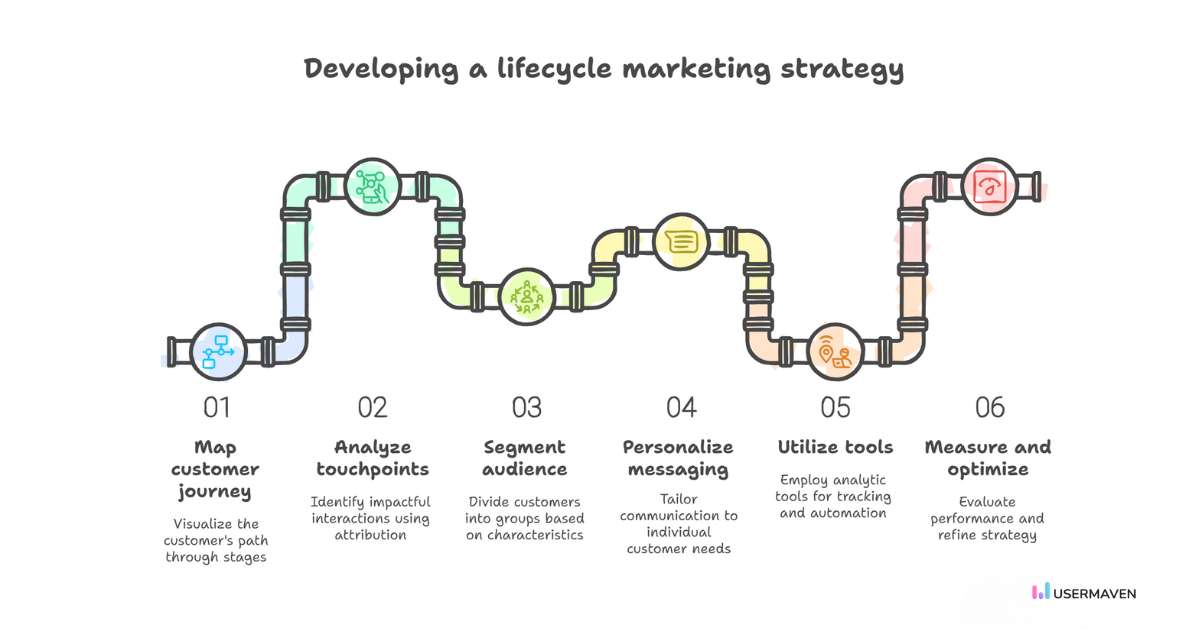
Here’s how to create a strategy that resonates at every stage.
Map out your customer journey
The first step is to understand your customer’s journey. Before implementing any tactics, you need a map. Think of this as the “big picture” view of your customer’s experience. The journey isn’t a straight line: customers move between stages, such as awareness, consideration, and loyalty, and sometimes they even circle back.
This is where it’s essential to track their behavior and understand what triggers each stage. Are they visiting your site, signing up for newsletters, or engaging with ads? Customer journey mapping is your tool to visualize these touchpoints, which helps you tailor your communication based on where they are in their journey.
Analyze all touchpoints with attribution
Understanding how customers move through your journey means understanding the touchpoints along the way. Attribution is all about giving credit where it’s due. It helps you figure out which channels, messages, and interactions have the most significant impact at each stage of the customer lifecycle.
With attribution tools, you can track and analyze the performance of every touchpoint, from first-touch to last-touch interactions, so you can optimize your campaigns based on what works. This allows you to guide your customers down the most effective path, adjusting your strategy to meet them where they’re most engaged.
Segment your audience
Not every customer is the same, and that’s where segmentation comes in. The power of segmentation lies in its ability to divide your audience into smaller, more manageable groups based on shared characteristics, such as demographics, behavior, or purchase history.
This approach ensures that your messages aren’t one-size-fits-all. For instance, a brand-new subscriber might benefit from a welcome series that introduces your product. At the same time, a returning customer might appreciate loyalty rewards or recommendations based on their previous purchases. Tailored communication at each stage fosters stronger connections and increases the likelihood of moving customers to the next stage.
Personalize your messaging
Now that you understand where your customers are and who they are, it’s time to tailor your messaging to them. Gone are the days of sending the same email to everyone on your list. Personalized communication feels more meaningful and resonates better.
Whether it’s sending a new user an introductory email, providing content that matches their interests, or offering a special discount to returning customers, personalization shows that you’re paying attention to their needs. Use the data you’ve gathered, whether through their browsing behavior, past purchases, or interactions with your brand, to craft messages that speak to them on a deeper level.
Utilize the right tools
Executing a successful lifecycle marketing strategy requires the right tools to track customer interactions, automate communications, and measure results. Tools like Usermaven and others can help you create personalized campaigns, manage customer data in a centralized location, and analyze key metrics to optimize your approach.
These tools help you monitor the customer journey in real-time. You’ll be able to understand which messages resonate, which stages need more attention, and which customers need follow-ups. With analytics dashboards at your disposal, you’ll have all the data you need to refine your approach.
Measure and optimize
A good strategy is never static; it needs to evolve. Once your lifecycle marketing campaigns are running, measure their effectiveness regularly to ensure optimal performance. Track metrics like engagement rates, customer retention, conversion rates, and lifetime value. These numbers will give you a clear picture of how your strategy is performing and where improvements can be made.
For instance, if you’re experiencing a high drop-off rate at a particular stage, it may be time to refine your messaging or offer incentives to encourage customers to progress through the funnel. With analytics tools, you can easily identify what’s working and what’s not, and make data-driven decisions that help optimize the customer journey.
Unlock insights that drive growth
*No credit card required
Metrics for lifecycle marketing
Tracking the right metrics is like having a GPS for your lifecycle marketing strategy: it helps you understand where you are, where you’re going, and how to get there efficiently.
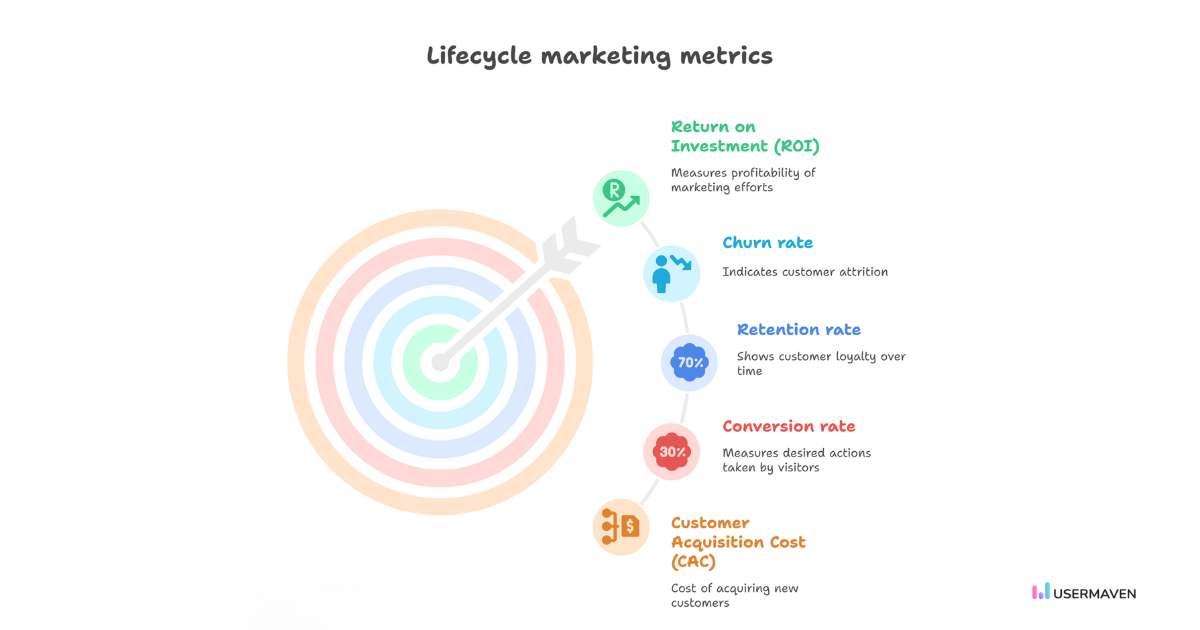
Here’s a breakdown of the key metrics you should keep an eye on:
- Customer Lifetime Value (CLV): This metric estimates the total revenue a customer will generate during their relationship with your brand. It’s crucial for understanding the long-term value of your customers and guiding decisions on customer acquisition and retention strategies.
- Customer Acquisition Cost (CAC): CAC measures the cost associated with acquiring a new customer, including marketing and sales expenses. Comparing CAC to CLV helps assess the efficiency of your acquisition strategies and ensures you’re investing wisely.
- Conversion rate: This is the percentage of visitors who take a desired action, such as making a purchase or signing up for a newsletter. A higher conversion rate indicates effective marketing and user experience strategies.
- Retention rate: Retention rate measures the percentage of customers who continue to do business with you over a specific period. High retention rates often lead to increased customer loyalty and higher CLV.
- Churn rate: Churn rate is the percentage of customers who stop doing business with you over a given period. A high churn rate can be detrimental to your business growth.
- Return on Investment (ROI): ROI measures the profitability of your marketing efforts. It’s calculated by dividing the net profit from a campaign by the campaign’s cost. A positive ROI indicates that your marketing investments are paying off.
Common challenges in lifecycle marketing and how to overcome them
Lifecycle marketing offers tremendous opportunities to build lasting relationships with your customers, but it also comes with its fair share of challenges.
From managing data to delivering personalized experiences at scale, here’s a look at some of the most common obstacles you might face, and how to overcome them.
Data integration issues
One of the biggest headaches in lifecycle marketing is integrating data from multiple sources. Your CRM, email platform, website analytics, and social media accounts all house valuable customer information, but if they’re not talking to each other, you’re left with fragmented insights.
The solution? Implementing unified platforms like Usermaven can streamline data management, providing a single source of truth. These platforms consolidate data from various touchpoints, allowing you to create a cohesive view of your customers’ journey. This integration not only saves time but also enhances the accuracy of your marketing strategies.
Measuring ROI
Determining the return on investment for lifecycle marketing efforts can be tricky. With multiple touchpoints and channels involved, attributing success to a single campaign or strategy isn’t always straightforward.
To navigate this, employ attribution models that consider the entire customer journey. Multi-touch attribution, for instance, assigns value to each interaction a customer has with your brand, providing a more accurate picture of what’s driving conversions.
Coupling this with robust analytics tools enables you to assess campaign effectiveness and make data-driven decisions to optimize future efforts.
How Usermaven helps in lifecycle marketing
When it comes to managing customer relationships and boosting retention, Usermaven is a powerful tool to help you every step of the way.
Think of it as your marketing assistant, providing real-time insights and actionable data that empower you to create a more personalized and impactful experience for your customers. Let’s dive into how Usermaven can elevate your lifecycle marketing strategy and make every touchpoint count.
SaaS insights
In the world of SaaS, effective lifecycle marketing isn’t just about attracting customers; it’s about understanding their behavior over time and using that data to build long-term, meaningful relationships. Usermaven’s product analytics features help you do just that by offering valuable insights into every stage of the customer journey.
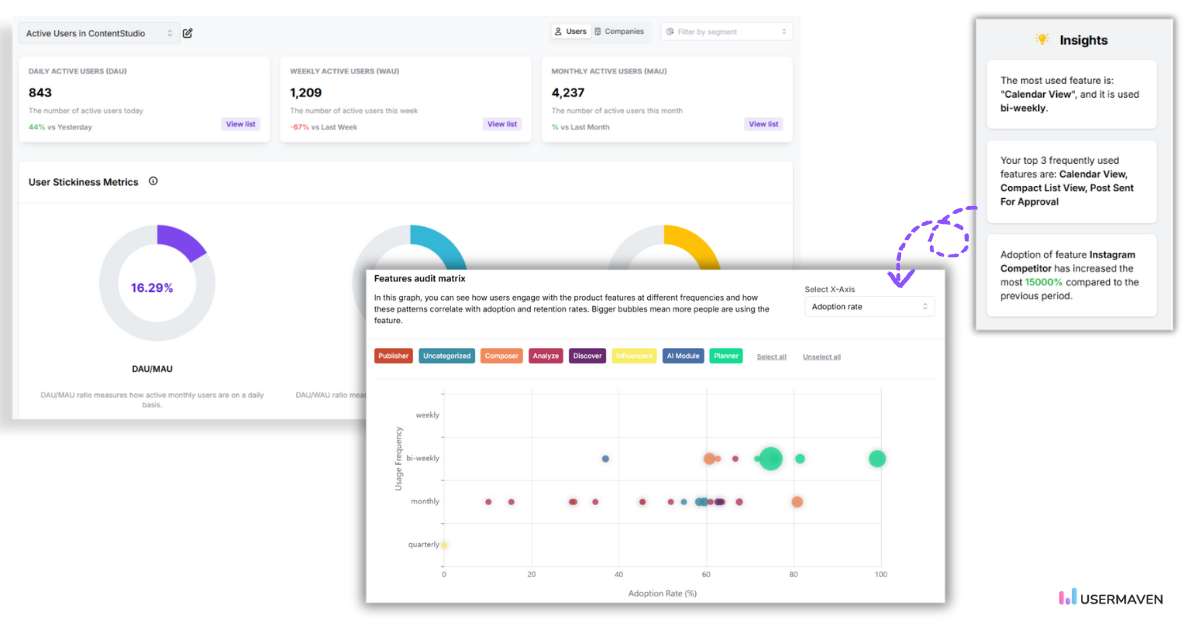
One of the key elements of lifecycle marketing is retention, and Usermaven’s retention analysis provides exactly that. By analyzing user cohorts, you can identify when users are likely to disengage and act before they slip away.
But it doesn’t stop there. Usermaven’s power users feature enables you to identify the most engaged users who consistently interact with your product. Nurturing these relationships turns them into brand ambassadors, strengthening loyalty and gathering valuable feedback.
On the other hand, the slipping away users feature helps you identify users whose activity is starting to wane, signaling potential churn. With this insight, you can take proactive steps to re-engage these users before they leave, offering them incentives or content tailored to their needs.
Together, these features provide a deeper understanding of your customer base, enabling you to optimize your lifecycle marketing strategy. By using product analytics effectively, you can make data-driven decisions that enhance customer satisfaction, boost retention, and ultimately, foster lasting loyalty.
Real-time analytics
Usermaven enables you to monitor customer behavior across multiple touchpoints in real-time. Whether they’re browsing your website, engaging with your emails, or interacting with your mobile app, you can track everything as it happens. This means you’re always in the loop.
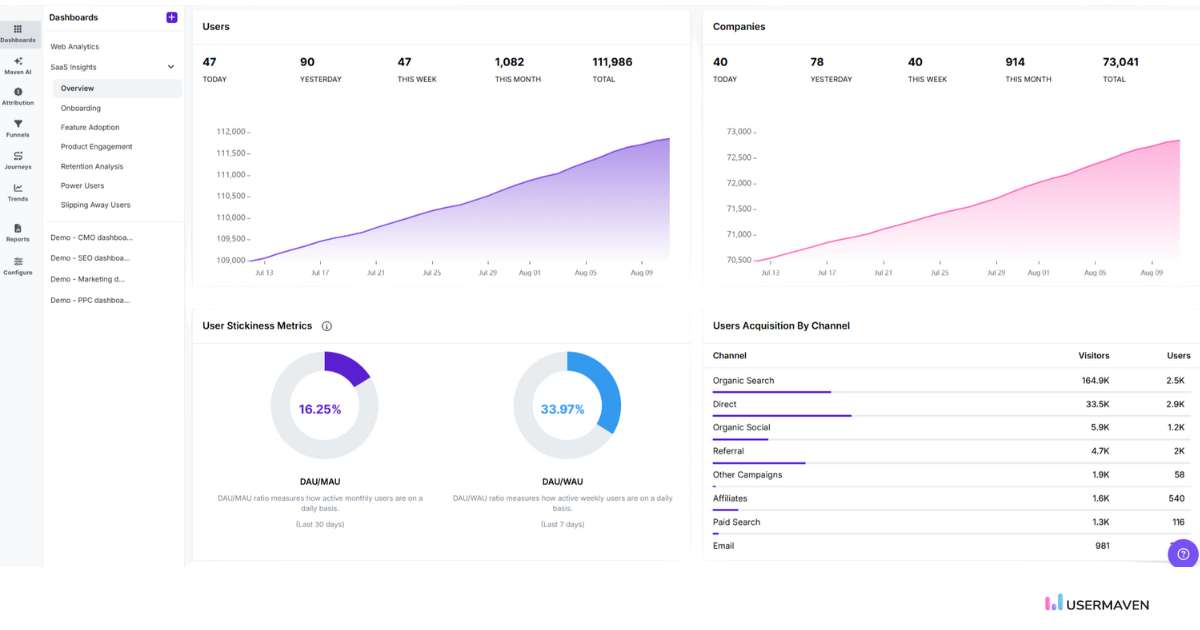
With real-time analytics and customizable dashboards tailored to your needs, you can quickly identify trends and patterns in customer behavior, enabling you to make data-driven marketing decisions on the fly. So, if something is working (or isn’t), you can adjust your strategies immediately.
No more waiting around for weekly or monthly reports to tell you what’s going on. With real-time data, you’re always ahead of the curve.
Segments
Not all customers are created equal, so why treat them the same? With segmentation, Usermaven makes it easy to create tailored experiences for different customer groups. By analyzing user data, you can segment your audience based on behavior, preferences, or lifecycle stage.
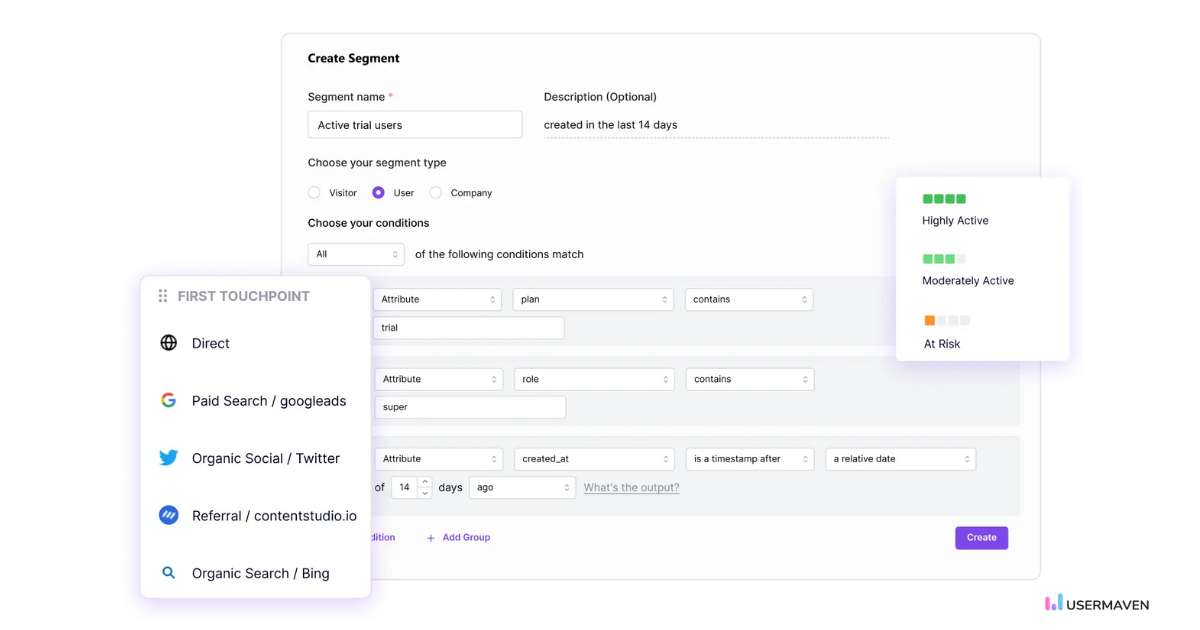
This allows you to create targeted campaigns that speak directly to the right audience. Whether it’s offering a discount to loyal customers or sending personalized content to those who have shown interest in a specific product, Usermaven helps ensure your messaging is always on point and relevant. Personalized experiences keep customers engaged and more likely to convert.
Funnels
When you think about the customer journey, it’s not just about getting them to convert; it’s about making sure each step of their experience is seamless. Funnel analysis with Usermaven helps you do exactly that. From initial awareness to final purchase, Usermaven enables you to track how customers progress through each stage of the funnel.
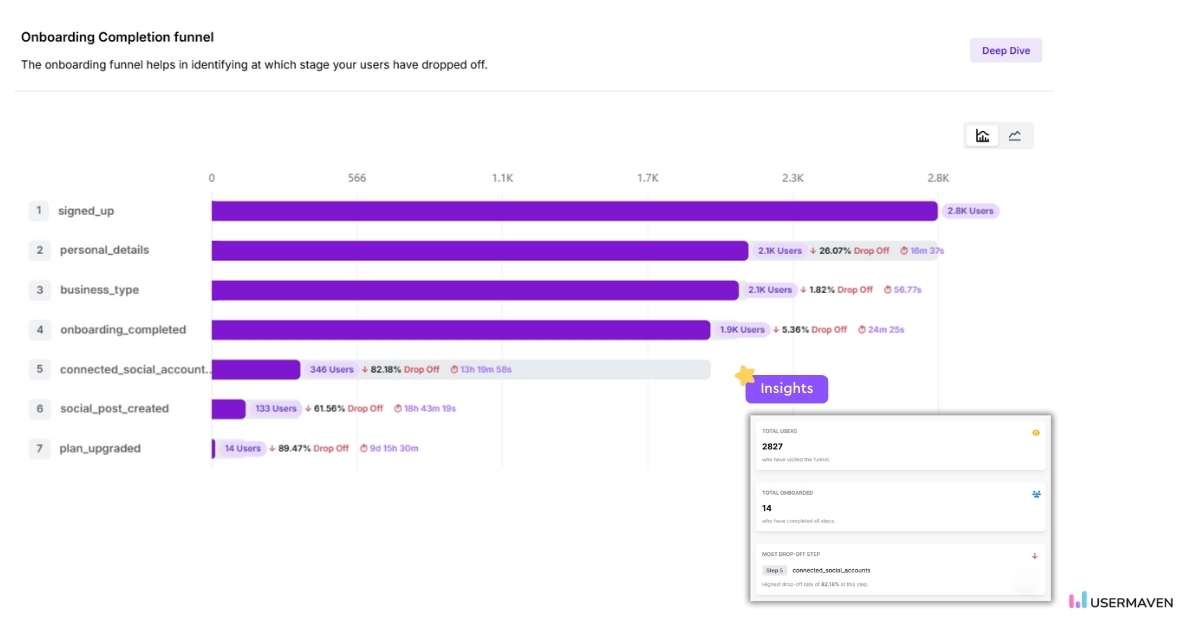
By analyzing the data, you can pinpoint where customers might be dropping off or what’s preventing them from moving to the next stage. With this insight, you can optimize each part of the funnel, whether that’s improving your messaging, offering incentives, or fine-tuning your marketing tactics.
The goal? To ensure that every lead has the best possible chance of converting.
User journeys
Beyond just tracking individual funnels, Usermaven lets you map out entire user journeys, providing an in-depth look at how customers interact with your brand across multiple touchpoints. This helps you understand the broader context of their behaviors and intentions, ensuring that no part of the journey is overlooked.
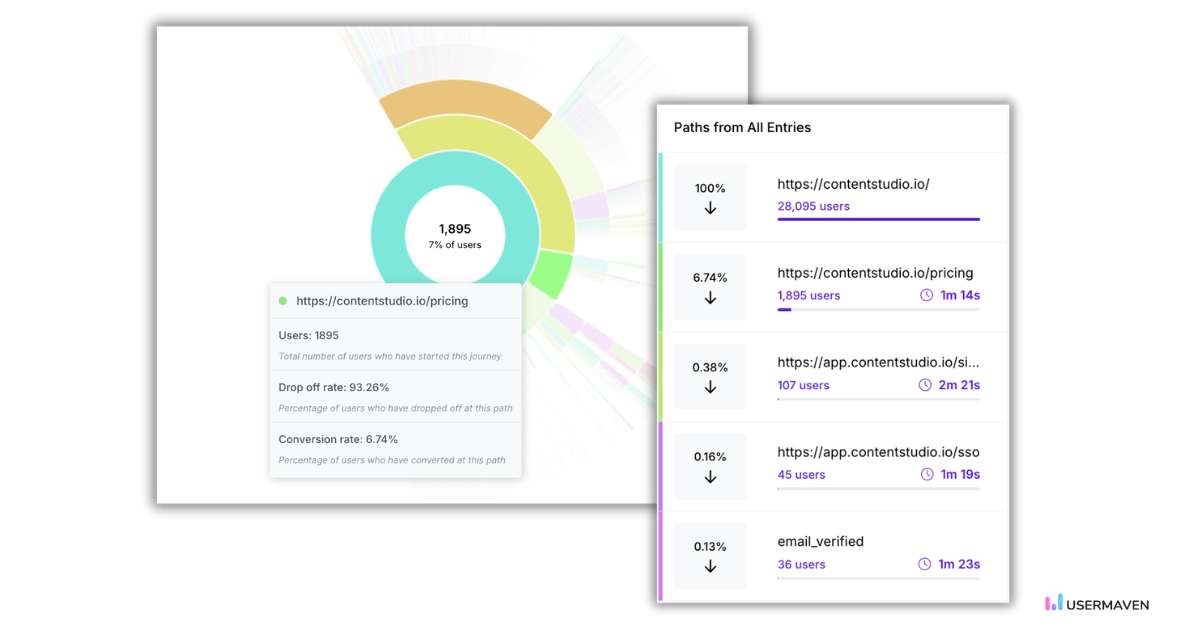
With this insight, you can create targeted touchpoints that guide them more effectively through the journey. Whether it’s delivering educational content during the awareness phase or sending personalized offers to encourage repeat purchases, Usermaven helps you nurture customers through every stage of their experience, ensuring they stay engaged and loyal.
Attribution
Understanding which channels are driving the most value can be tricky, but Usermaven makes it easier with attribution modeling. This tool helps you identify which marketing channels (email, paid ads, social media, etc.) are most effective in moving customers through the funnel and driving conversions.
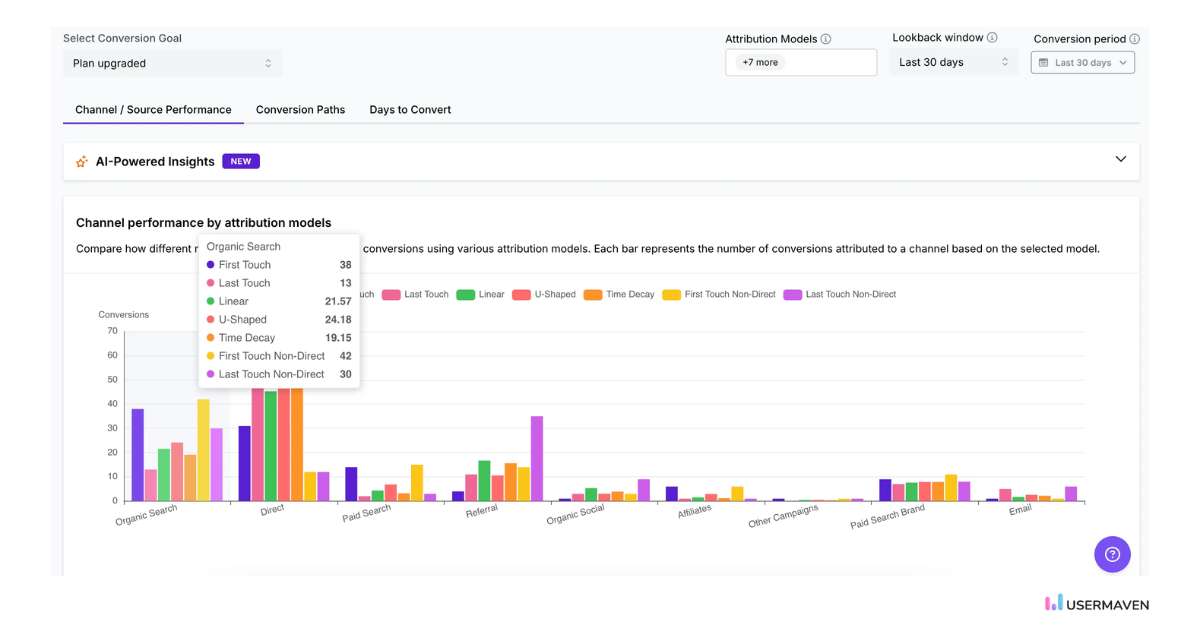
With this clarity, you can allocate your resources more efficiently, ensuring that your efforts are focused on the channels that deliver the best ROI. It’s all about making data-driven decisions to maximize your marketing impact and keep your resources working smarter, not harder.
Usermaven doesn’t just provide data; it gives you the insights and tools to take meaningful action. With no-code event tracking and an intuitive setup, you can easily capture key customer actions across every stage of the lifecycle, without needing a technical team. From tracking real-time behaviors to personalizing content and optimizing your funnels and user journeys, it’s the perfect solution for anyone looking to elevate their lifecycle marketing.
Ready to elevate your lifecycle marketing strategy? Usermaven’s got you covered.
See Usermaven in action
Book a free demo and discover how powerful analytics can grow your business.
*No credit card required
Conclusion
Lifecycle marketing is all about building lasting relationships with your customers, rather than focusing solely on the initial sale. By nurturing customers at every stage, you create stronger connections that drive loyalty and long-term success. Tools like Usermaven make it easier than ever to implement effective lifecycle marketing strategies, offering real-time insights, personalized campaigns, and event tracking that simplify the entire process.
By adopting a lifecycle marketing approach, businesses can keep customers engaged, increase customer retention, and position themselves for sustained growth. It’s about focusing on the journey, not just the destination.
FAQs about lifecycle marketing
1. What is lifecycle marketing?
Lifecycle marketing is a strategy that focuses on engaging customers at every stage of their journey with your brand, from initial contact to becoming loyal advocates. It’s about delivering the right message at the right time to nurture relationships and drive long-term success.
2. Is lifecycle marketing the same as CRM?
Not exactly. While both aim to enhance customer relationships, CRM (Customer Relationship Management) is more about managing and analyzing customer interactions and data. Lifecycle marketing, on the other hand, is a proactive approach that uses insights from CRM to create targeted campaigns that guide customers through their journey with your brand.
3. What does a lifecycle marketing manager do?
A lifecycle marketing manager is responsible for developing and executing strategies that engage customers at every stage of their journey. They analyze customer data, create personalized campaigns, and collaborate with various teams to ensure a seamless and engaging customer experience.
4. What tools can assist with lifecycle marketing?
The right tools are crucial for tracking customer behavior, analyzing data, and delivering personalized experiences. With real-time analytics and segmentation tools, you can engage customers at every stage of their journey. Tools like Usermaven simplify this by providing actionable insights and personalized messaging, making it easier to optimize your lifecycle marketing efforts and build stronger customer relationships.
Try for free
Grow your business faster with:
- AI-powered analytics & attribution
- No-code event tracking
- Privacy-friendly setup


